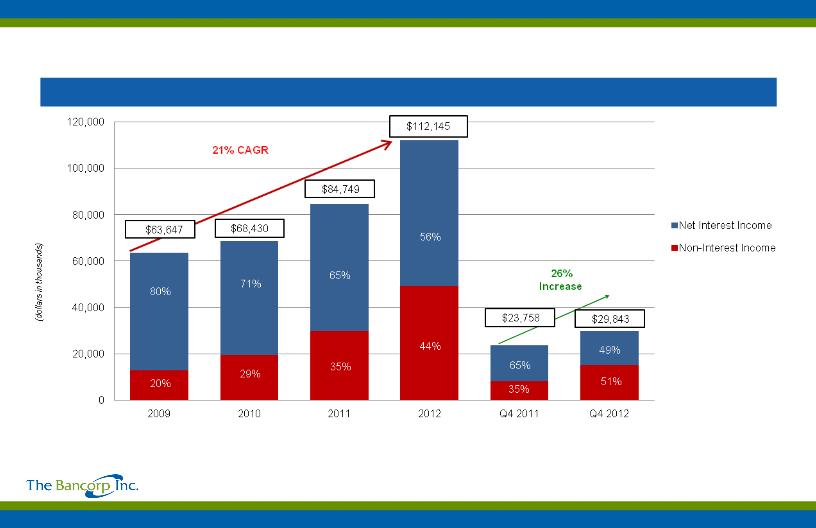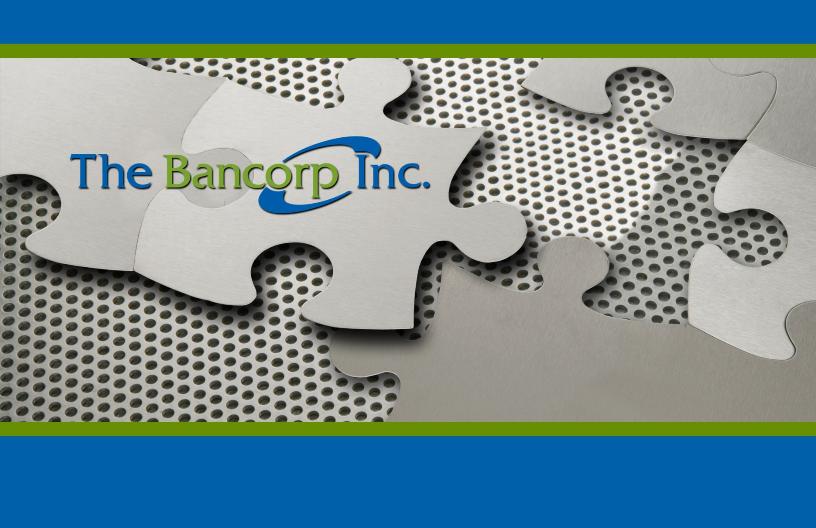Attached files
| file | filename |
|---|---|
| 8-K - THE BANCORP, INC. FORM 8-K - Bancorp, Inc. | bancorp8k.htm |
Exhibit 99.1

NASDAQ: TBBK
The Bancorp, Inc. • Investor Presentation
4th Quarter, 2012
4th Quarter, 2012

Forward-Looking Statements
Safe Harbor Statement under the Private Securities Litigation Reform Act of 1995:
Statements in this presentation regarding The Bancorp, Inc.’s business that are not historical facts are “forward
-looking statements” that involve risks and uncertainties. These statements may be identified by the use of
forward-looking terminology, including the words “may,” “believe,” “will,” “expect,” “anticipate,” “estimate,”
“continue,” or similar words. For further discussion of these risks and uncertainties, see The Bancorp, Inc.’s
filings with the SEC, including the “risk factors” section of The Bancorp, Inc.’s Form 10-K. These risks and
uncertainties could cause actual results to differ materially from those projected in the forward-looking
statements. The forward-looking statements speak only as of the date of this presentation. The Bancorp, Inc.
does not undertake to publicly revise or update forward-looking statements in this presentation to reflect
events or circumstances that arise after the date of this presentation, except as may be required under
applicable law.
-looking statements” that involve risks and uncertainties. These statements may be identified by the use of
forward-looking terminology, including the words “may,” “believe,” “will,” “expect,” “anticipate,” “estimate,”
“continue,” or similar words. For further discussion of these risks and uncertainties, see The Bancorp, Inc.’s
filings with the SEC, including the “risk factors” section of The Bancorp, Inc.’s Form 10-K. These risks and
uncertainties could cause actual results to differ materially from those projected in the forward-looking
statements. The forward-looking statements speak only as of the date of this presentation. The Bancorp, Inc.
does not undertake to publicly revise or update forward-looking statements in this presentation to reflect
events or circumstances that arise after the date of this presentation, except as may be required under
applicable law.
1

The Bancorp, Inc. - Planning for Growth with Safety and Soundness
• Strategic Goal:
§ Create and grow a stable, profitable institution with the optimum reliance on capital, risk management
and technology, and manage it with knowledgeable and experienced management and senior
officers
and technology, and manage it with knowledgeable and experienced management and senior
officers
• Tactical Approach:
§ Deposits - Utilize a branchless banking network to gather scalable deposits through strong
contractual relationships at costs significantly below peers
contractual relationships at costs significantly below peers
§ Assets - Focus on asset classes including loans and securities appropriate to our expertise to
achieve returns above risk-adjusted peer net interest margins
achieve returns above risk-adjusted peer net interest margins
§ Non-Interest Income - Grow non-interest income disproportionately in relation to non-interest
expense through our deposit and asset approaches
expense through our deposit and asset approaches
§ Operating Leverage - Leverage infrastructure investment to grow earnings by creating efficiencies
of scale
of scale
2

The Bancorp, Inc. - Planning for Growth
3
Consumer Distribution Channel Penetration
Percent of U.S. Households, 1999-2009
Source: Federal Reserve, FRB Boston, FRB Philadelphia, SRI Consulting, University of Michigan, Mintel, Celent, Bank of America, comScore, Nielsen Mobile, Wall Street Journal, Mercatus Analytics,
Fiserv, American Bankers Associaton
Fiserv, American Bankers Associaton

Business Model: A Distinct Business Strategy (1)
4
Assets
Deposits
Deposits
Prepaid Cards
Open Loop Prepaid Cards
• Deposits
• Non-interest Income
Healthcare
Health Savings Accounts
and Flexible Spending
Accounts
and Flexible Spending
Accounts
• Deposits
• Non-interest Income
Payment Acceptance
Credit, Debit Card and
ACH Processing
Credit, Debit Card and
ACH Processing
• Deposits
• Non-interest Income
Wealth Management
Deposits and Loans for
Clients of Wealth Firms
Clients of Wealth Firms
• Interest Income
• Deposits
• Non-interest Income
Securities Portfolio
Primarily highly rated
government obligations
government obligations
• Interest Income
Government Guaranteed
Lending
Lending
Loans to franchisees;
75% guaranteed by
U.S. government
75% guaranteed by
U.S. government
• Interest Income
Automobile Fleet
Leasing
Leasing
Well-collateralized
Automobile Fleet Leasing
Automobile Fleet Leasing
• Interest Income
• Non-interest Income
Community Bank
Traditional Community
Banking Products
Banking Products
• Interest Income
• Deposits
• Non-interest Income
40%
5%
8%
30%
6%
GGL:
1%
1%
7%
(1) For the above presentation, revenue for asset-generating departments includes all revenue from the assets they fund with deposits they generate. It also includes half
the revenue on assets they generate but do not fund. The other half of that revenue is allocated to deposit-producing departments. The revenue shown was generated
in 2012 with the exception of segments marked 2010.
the revenue on assets they generate but do not fund. The other half of that revenue is allocated to deposit-producing departments. The revenue shown was generated
in 2012 with the exception of segments marked 2010.
2010 Prepaid
Cards: 30%
2010 Community
Bank: 40%
3%

Prepaid Gross Dollar Volume (GDV) (1) and Cardholder Growth (2)
5
(1) Gross Dollar Volume (GDV) is the total amount spent on all cards outstanding within a given period. The bar graph represents the gross dollar volume for the period segmented by the program
contract date.
contract date.
(2) Number of active cards as of year-end of the stated year.
$

Post Provision Income (1)
Revenue Composition
6
(1) Post provision income is calculated as follows: net interest income less provision for loan and lease losses plus non-interest income excluding gains on sales of investment securities and other than
temporary impairment on securities held-to-maturity.
temporary impairment on securities held-to-maturity.
$

Net Interest Income Generators
Compressed Interest Rate Environment
7
$
* Other is comprised of net interest income produced by the following areas: Investment Securities, Leasing Portfolio, Government Guaranteed Lending, and Wealth Management.

8
$
Non-Interest Income-Generating Strategies: Growth and Sustainability
Continued Growth in Non-Interest Income
$19,524
84%
Increase
Increase
(1) Excludes gains on investment securities
*Not meaningful

Scalable Business Model
9
Non Interest Income / Non Interest Expense (%)¹
4 Non-interest income is approximately half of non-interest expense, driving improving operating earnings
4 Cost of customer acquisition continues to decline due to strength of affinity relationships

Operating Leverage
10
Adjusted Operating Earnings(1),(2)
(1) As a supplement to GAAP, Bancorp has provided this non-GAAP performance result. The Bancorp believes that this non-GAAP financial measure is useful because it allows investors to assess its
operating performance. Management utilizes adjusted operating earnings to measure the combined impact of changes in net interest income, non-interest income and certain other expenses.
Adjusted operating earnings exclude the impact of the provision for loan losses, income taxes, securities gains and losses and certain non-recurring items. Other companies may calculate adjusted
operating earnings differently. Although this non-GAAP financial measure is intended to enhance investors’ understanding of Bancorp’s business and performance, it should not be considered, and
is not intended to be, a substitute for net income calculated pursuant to GAAP.
operating performance. Management utilizes adjusted operating earnings to measure the combined impact of changes in net interest income, non-interest income and certain other expenses.
Adjusted operating earnings exclude the impact of the provision for loan losses, income taxes, securities gains and losses and certain non-recurring items. Other companies may calculate adjusted
operating earnings differently. Although this non-GAAP financial measure is intended to enhance investors’ understanding of Bancorp’s business and performance, it should not be considered, and
is not intended to be, a substitute for net income calculated pursuant to GAAP.
(2) For reconciliation detail, please see Appendix.
(3) Compound annual growth rate is calculated for the fourth quarters of 2009, 2010, 2011, and 2012.
$

• Community Bank
§ Offers traditional community banking products and services targeting the
highly fragmented Philadelphia/Wilmington banking market
highly fragmented Philadelphia/Wilmington banking market
• Automobile Fleet Leasing
§ Well-collateralized automobile fleet leasing
• Average transaction: 8-15 automobiles, $350,000
• 30% of portfolio leased by government agencies
• Wealth Management
§ 15 affinity groups, managing & administering $1.8 trillion in
assets
assets
• SEI Investments, Legg Mason, Genworth Financial Trust
Company, Franklin Templeton
Company, Franklin Templeton
§ Generates securities backed and other loans
• Government Guaranteed Lending
§ Loans from $150,000 to $5.0 million primarily to franchisees such as UPS
Stores, Massage Envy, FASTSIGNS and Save a Lot which have a 75%
guaranty by the U.S. Small Business Administration. Approved Franchise
and Medical Guidance lines of over $500 million.
Stores, Massage Envy, FASTSIGNS and Save a Lot which have a 75%
guaranty by the U.S. Small Business Administration. Approved Franchise
and Medical Guidance lines of over $500 million.
• Securities
Primarily:
§ High credit quality tax exempt municipal obligations
§ U.S. Government agency securities primarily 3-5 year average lives and
other highly rated mortgage-backed securities
other highly rated mortgage-backed securities
11
|
Category
|
Balance
|
Balance
|
Avg. Yield
|
|
|
(in thousands)
|
|
|
|
Community Bank
|
$1,403,487
|
$ 1,418,121
|
4.15%
|
|
Government Guaranteed
Lending |
90,795
|
32,080
|
5.19%
|
|
Wealth Management
|
252,475
|
164,945
|
2.79%
|
|
Leasing Portfolio
|
156,097
|
129,682
|
7.10%
|
|
Investment Securities
|
763,244
|
466,248
|
2.45%
|

Non-Accrual Loans/Total Loans(1)
Asset Quality Overview
12
(1) Regional peers include publicly traded Mid-Atlantic commercial banks with assets between $1 billion and $4 billion as of September 30, 2012; graphs represent median values.
(2) Texas Ratio = (Non-accrual Loans + Restructured Loans + Loans 90 + days past due + OREO)/(Loss Reserves + Tangible Equity). TBBK computed with consolidated capital. Source: SNL Financial
(2) Texas Ratio = (Non-accrual Loans + Restructured Loans + Loans 90 + days past due + OREO)/(Loss Reserves + Tangible Equity). TBBK computed with consolidated capital. Source: SNL Financial

Growth Engine: Where Do Deposits Come From?
13
|
December 31, 2012
|
|
Category
|
Balance
(in millions)
|
Avg. Cost
|
|
Community Bank
|
$ 341
|
0.32%
|
|
Healthcare
|
330
|
0.55%
|
|
Prepaid Cards
(including demand deposit accounts)
|
1,290
|
0.06%
|
|
Wealth Management
|
790
|
0.47%
|
|
Payment Acceptance
|
225
|
0.60%
|
|
1031 Exchange
|
337
|
0.37%
|
|
Total Deposits: $3.3 billion
|
|
Average Cost: 0.31%
|
|
(Peer Average Cost: 0.49%)(1)
|
(1) Peer data source as of September 2012: Uniform Bank
Performance Report for Banks $1-5 B in assets measuring
interest expense to average interest earning assets.
Performance Report for Banks $1-5 B in assets measuring
interest expense to average interest earning assets.

Deposit-Generating Strategies: Sticky and Long-Term
The Bancorp has long-term, often exclusive agreements in place with its private label banking
partners.
partners.
14
|
Private Label Deposits by Remaining Contractual Term
|

Deposit-Generating Strategies: Growth and Low Cost
The Bancorp has experienced strong growth in deposits at below-peer costs.
15
|
Growth in Average Deposits
|
|||
|
|
December 31
YTD Average Deposits
(dollars in thousands)
|
Cost of Funds(2)
|
Peer Cost of Funds(1)
|
|
2012
|
$ 3,148,977
|
0.31%
|
0.49%
|
|
2011
|
$ 2,562,132
|
0.42%
|
0.87%
|
|
Change
|
$ 586,845
|
-0.11%
|
-0.38%
|
|
% Change
|
23%
|
-26%
|
-44%
|
(1) Peer data source as of September 2012: Uniform Bank Performance Report for Banks $1-5 B in assets measuring interest expense to average interest earning assets.
(2) Bancorp cost of funds is lower after consideration of seasonal deposits.

The Bancorp, Inc. - Planning for Growth with Safety and Soundness
• Strategic Goal:
§ Create and grow a stable, profitable institution with the optimum reliance on capital, risk management
and technology, and manage it with knowledgeable and experienced management and senior
officers
and technology, and manage it with knowledgeable and experienced management and senior
officers
• Tactical Approach:
§ Deposits - Utilize a branchless banking network to gather scalable deposits through strong
contractual relationships at costs significantly below peers
contractual relationships at costs significantly below peers
§ Assets - Focus on asset classes including loans and securities appropriate to our expertise to
achieve returns above risk-adjusted peer net interest margins
achieve returns above risk-adjusted peer net interest margins
§ Non Interest Income - Grow non-interest income disproportionately in relation to non-interest
expense through our deposit and asset approaches
expense through our deposit and asset approaches
§ Operating Leverage - Leverage infrastructure investment to grow earnings by creating efficiencies
of scale
of scale
16

NASDAQ: TBBK
APPENDIX

Capital Ratios and Selected Financial Data
18
|
|
|
As of or for the three months ended
|
As of or for the three months ended
|
|
|
|
December 31, 2012
|
December 31, 2011
|
|
|
|
(dollars in thousands)
|
(dollars in thousands)
|
|
Selected Capital and Asset Quality Ratios:
|
|
|
|
|
|
Equity/assets
|
9.10%
|
9.02%
|
|
|
Tier 1 capital to average assets
|
9.99%
|
8.69%
|
|
|
Tier 1 capital to total risk-weighted assets
|
16.39%
|
14.64%
|
|
|
Total capital to total risk-weighted assets
|
17.65%
|
15.89%
|
|
|
Allowance for loan and lease losses to total loans
|
1.74%
|
1.69%
|
|
|
|||
|
Balance Sheet Data:
|
|
|
|
|
|
Total assets
|
$ 3,699,659
|
$3,010,681
|
|
|
Total loans, net of unearned costs (fees)
|
1,902,854
|
1,744,828
|
|
|
Allowance for loan and lease losses
|
33,040
|
29,568
|
|
|
Total cash and cash equivalents
|
968,092
|
749,174
|
|
`
|
Total investments
|
763,244
|
466,248
|
|
|
Deposits
|
3,313,221
|
2,682,551
|
|
|
Short-term borrowings
|
0
|
0
|
|
|
Shareholders’ equity
|
336,677
|
271,479
|
|
|
|||
|
Selected Ratios:
|
|
|
|
|
|
Return on average assets
|
0.62%
|
0.43%
|
|
|
Return on average common equity
|
7.04%
|
4.84%
|
|
|
Net interest margin
|
2.73%
|
2.89%
|
|
|
Book value per share
|
$ 9.06
|
$ 8.18
|

Current Loan Portfolio and Asset Quality Overview at 12/31/2012
|
Category
(dollars in thousands)
|
Balance
|
% of Total
Loans |
Nonaccrual
Loans |
Nonaccrual/
Total Loans
|
OREO
|
30-89 Days
Delinquent |
90+ Days
Delinquent |
Q4 2012
Quarterly Charge-offs (net) |
|
Commercial
|
$ 470,109
|
25%
|
$ 10,459
|
0.55%
|
$ 2,500
|
$ 5,750
|
$ 1,350
|
$ (133)
|
|
Commercial mortgage
|
617,069
|
32%
|
9,175
|
0.48%
|
891
|
986
|
2,412
|
(2,861)
|
|
Construction
|
258,684
|
14%
|
4,538
|
0.24%
|
850
|
-
|
667
|
( 4,386)
|
|
Direct financing leases
(auto leases) |
156,697
|
8%
|
-
|
0.00%
|
-
|
2,481
|
6
|
-
|
|
Residential mortgage
|
97,717
|
5%
|
91
|
0.01%
|
-
|
1,924
|
-
|
-
|
|
Securities backed loans
and other |
296,915
|
16%
|
927
|
0.05%
|
-
|
437
|
-
|
(42)
|
|
Total
|
$ 1,897,191
|
100%
|
$ 25,190
|
1.33%
|
$4,241
|
$ 11,578
|
$ 4,435
|
$ (7,422)
|
19

Bancorp’s Real Estate Lending Business Targets Well-Positioned Attractive,
Stable Markets
Stable Markets
• Commercial lending is substantially all in greater Philadelphia/Wilmington metropolitan area
§ Consists of the 12 counties surrounding Philadelphia and Wilmington, including Philadelphia,
Delaware, Chester, Montgomery, Bucks and Lehigh Counties in Pennsylvania; New Castle County in
Delaware; and Mercer, Burlington, Camden, Ocean and Cape May Counties in New Jersey.
Delaware, Chester, Montgomery, Bucks and Lehigh Counties in Pennsylvania; New Castle County in
Delaware; and Mercer, Burlington, Camden, Ocean and Cape May Counties in New Jersey.
• Philadelphia/Wilmington and the surrounding markets encompass a large population, stable economic
activity and attractive demographics.
activity and attractive demographics.
• Throughout the current down cycle and in prior cycles, the Philadelphia region has exhibited significant
stability, which is reflected in a lower negative equity compared to the rest of the nation, as shown below.
stability, which is reflected in a lower negative equity compared to the rest of the nation, as shown below.
20
|
1st Quarter 2012 (1)
|
US
|
NJ
|
DE
|
PA
|
|
% of Homes with
Negative Equity |
22.0%
|
19.9%
|
15.8%
|
9.6%
|
(1) Source: CoreLogic, Q3 2012



NASDAQ: TBBK
www.thebancorp.com
